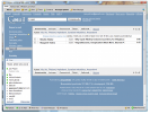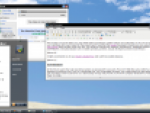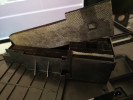The Opera program first appeared around 1994 as a web browser developed for a Norwegian telecommunication company. Eventually it became a standalone commercial product that excelled in the speed of web site loading. That was in the time of the old Internet Explorer, when Firefox or Chrome were not around and when most of us used dial-up connection to connect to the Internet.
I got to like Opera not only because of its speed, but also thanks to its tab interface. I did not want to use a superstructure over Internet Explorer (MyIE, today's Maxthon) and Mozilla was awkward and – most of all – ugly.
The disadvantage of Opera was then the forced advertisements that you were able to get rid of only by buying the paid version and minor problems with displaying some web sites. Over time, Opera overcame its childhood complaints and – what is more – it is now completely free and advertismentless.
Opera is well known for its equipment. Apart from the web browser it offers an inbuilt e-mail client called Opera Mail (highly recommended if you prefer webmails), a communicator and a download manager. Do you remember the sensation when the support of an inbuilt Bittorrent client was announced? Opera also offers tools for notes and an address book and a support of different widgets – useful mini-applications and games. The newest Opera version adds support for file sharing.
Let's have a look at some interesting functions of this web browser. Some are new to the current Opera 10.10, others have been a part of Opera for some time. However, they are still worth reminding.
Opera Unite
The newest improvement that Opera 10.10 has brought. The new tool called Opera Unite makes Opera an instrument for sharing content. Do you need to show photographs to your friends, to share files with them, to communicate with them instantly without using an e-mail or a communicator or to allow them to send you a message to your noticeboard? Opera Unite 10.10 will allow you to do it all. The only thing that you need to do is to enable it in the left side panel, to select one of the components, to log on to your Opera account and you can begin.
I see the greatest advantage of Opera Unite in the possibility to easily share photos and other files. You do not need to upload them anywhere, the others will download them directly from your computer. Using this method you can get rid of one semistep. Sharing is as simple as selecting a data folder in any other program. The only difference is that you will determine whether the shared content is password protected, visible for browsers or available only within the local network. In the end you just send the generated address to the other users. The address is available as long as the browser is opened and the Opera Unite service active.
Opera 10.10
Opera Turbo
Web browsing in Opera is very fast as it is. I do not find the minimal differences in speed that the individual browsers achieve with every new version very interesting. However, if you need to speed the web browsing up, turn on the Opera Turbo function. You will find it under the third button in the bottom status bar. After you enable the Turbo, an information stating how many times faster did the page load compared to the normal mode.
The difference in speed is achieved by compressing the downloaded content, mostly the images. The images are displayed in much worse quality, which is simply a tax to pay for the speed. Which do you prefer? It is up to you.
Opera 10.10
Page previews
Another interesting feature that will make browsing a greater amount of web pages at once easier are their previews. Unfortunately, Opera 10.10 does not support previews in the Windows 7 task bar like Internet Explorer. On the other hand it offers a strip with web page previews in its window. The only thing that you have to do is to move the tab separator with the page names down using the mouse. The text descriptions will then change to image previews.
Opera 10.10
Speed Dial
The list of the most favorite web sites in the form of the Speed Dial feature/function has been in Opera for quite some time but still, it is worth reminding. When you open an empty page, tiles will appear, in which the previews of the selected web sites can be displayed. You can open them by a single click. You can place the selected web sites into the tiles simply by dragging them from the list of the opened sites or by entering their address after clicking the tile or by selecting the required page from the tabs.
Opera 10.10
Opera Link
Just as Firefox has its Foxmarks add-on (now newly xmarks.com), as Google plans it for its Chrome, Opera offers the same in a form of the Opera Link tool. It is a synchronization instrument that helps you to keep the same content in different Opera installations. It allows you to easily synchronize your favorite web links, notes, Speed Dial and other information stored in Opera not only between different computers, but also between different mobile versions.
Opera 10.10
Tools for developers
Web site creators will surely be interested in the support for web site debugging. Opera had offered those tools before Internet Explorer, Safari or Chrome did. They can be displayed using the Tools | Advanced | Developer Tools menu. At the bottom a new frame for debugging cascade style sheets and scripts will open that will remind you of Firebug from Firefox. It will also show you a chart depicting the speeds of loading the individual web page components. You can use it to find out, which part of the web site is the most problematic from this point of view.
Opera 10.10
RSS reader and Google Reader implementation
Today, all web browsers have an inbuilt support for reading RSS outputs from individual web sites. Opera 10.10 uses its Opera Mail E-mail client to perform this function. In addition to that, you can choose different web clients from a drop-down menu and Opera will then forward you to a page, where you will be one click away from adding them into the RSS reader.
Opera 10.10
Mouse gestures
Mouse gestures support has also been a part of Opera for a long time. It does not require any individually installed add-ons. Mouse gestures are activated for example by pressing the right mouse button and moving the mouse to the left - this gesture allows you to go to the previous page. Meanwhile, Opera will just ask you, whether you wish to active the mouse gestures function. The list of the mouse gestures can be found in the Tools | Preferences menu. In a new window you will then go to the Advanced | Shortcuts tab. By clicking the first Edit button you can then display the list of the mouse gestures and also to add your own.
Opera 10.10
Voice control
Opera's voice control was once a great sensation, just like the inbuilt BitTorrent. I think that this function has been somewhat forgotten in our country. The reason is that it supports only the English pronunciation. Go to Tools | Preferences | Voice. Select the activation key and after you press the Edit button, choose the initial word. See the supported commands and close the windows. Press the activation key, say the command and release the key. If you pronounce the command properly, Opera will perform the desired task, otherwise it will inform you that it did not understand your requirement.
Opera 10.10
Working with marked text
I dare to say that the last described Opera function is the one that is the most frequently used. While in other browsers it is necessary to right-click the marked text and then to select a command from a context menu, in Opera you can simply double-click the required text - it will be marked and the menu will appear. The menu allows you to copy the text, to insert it into your notes, to translate it, to open a web address (even if it is not clickable) and to send the text by E-mail.
And yes, Opera can also read. Reading is limited only to English text and it is available after installing a necessary add-on (that will be offered automatically), but still, it is possible. Unfortunately, reading does not work in certain web sites.
Opera 10.10 is really an excellent browser. It uses a different approach then Firefox - it makes an effort to implement a maximum of useful functions directly into the basic installation, which can be likeable to many users. On the other hand, Opera's desire to be visible at any cost is not so likeable. But enough has been written about this problem elsewhere.
















